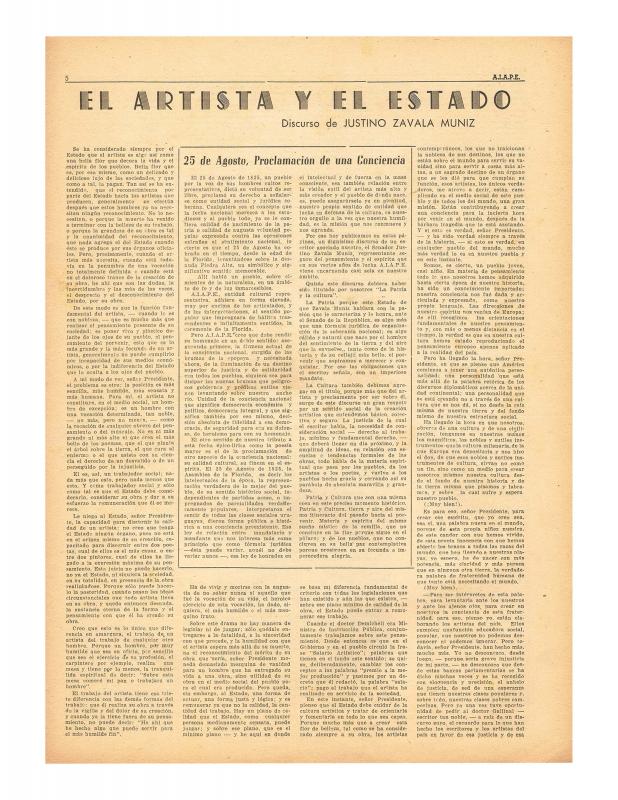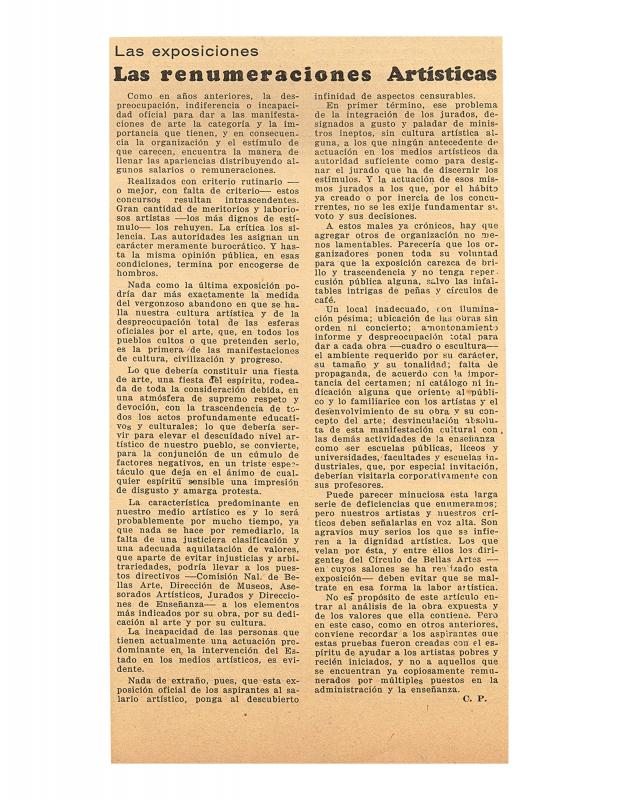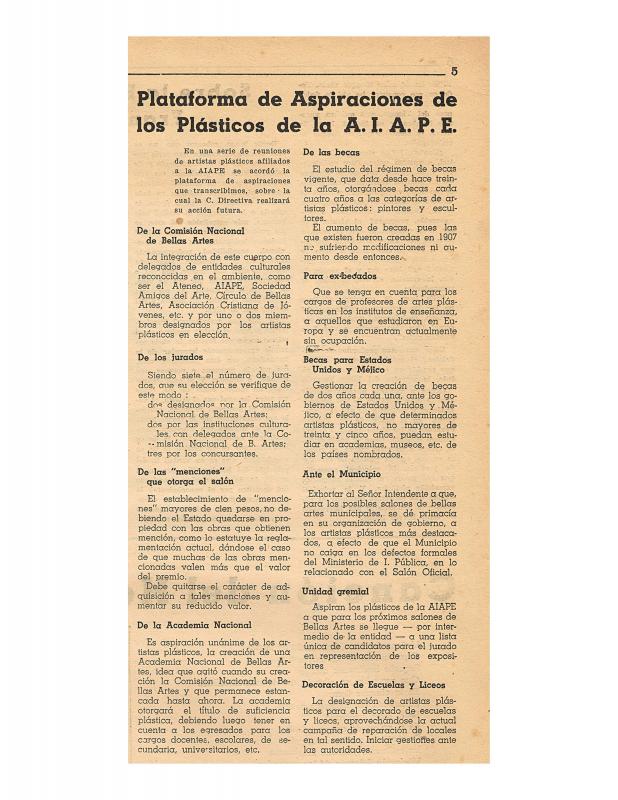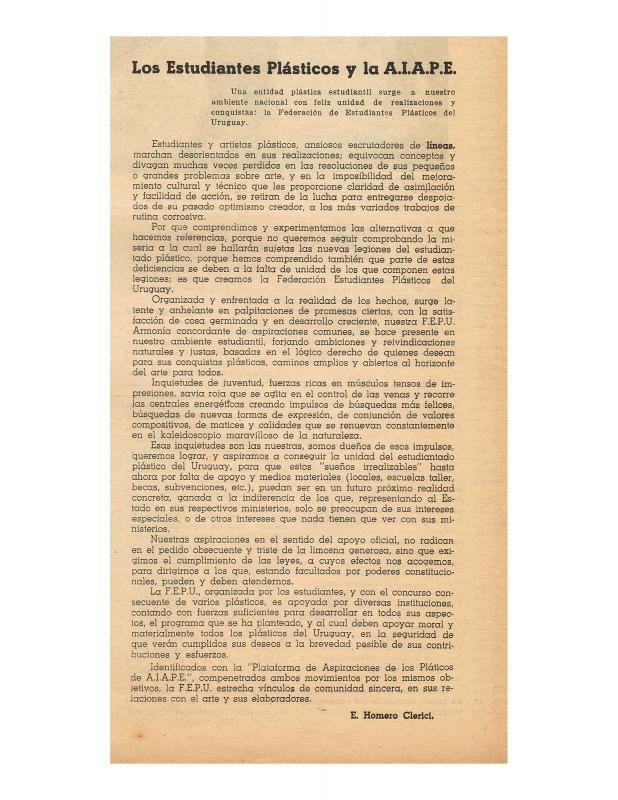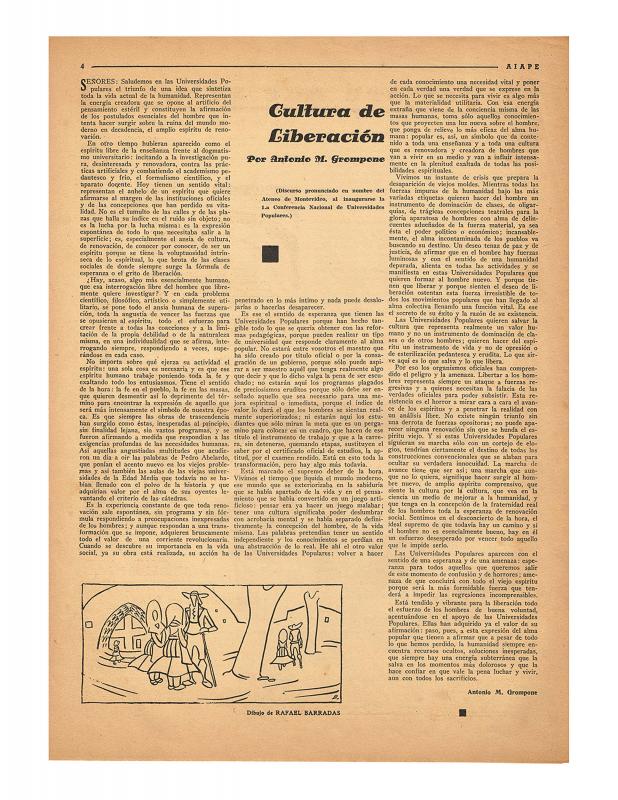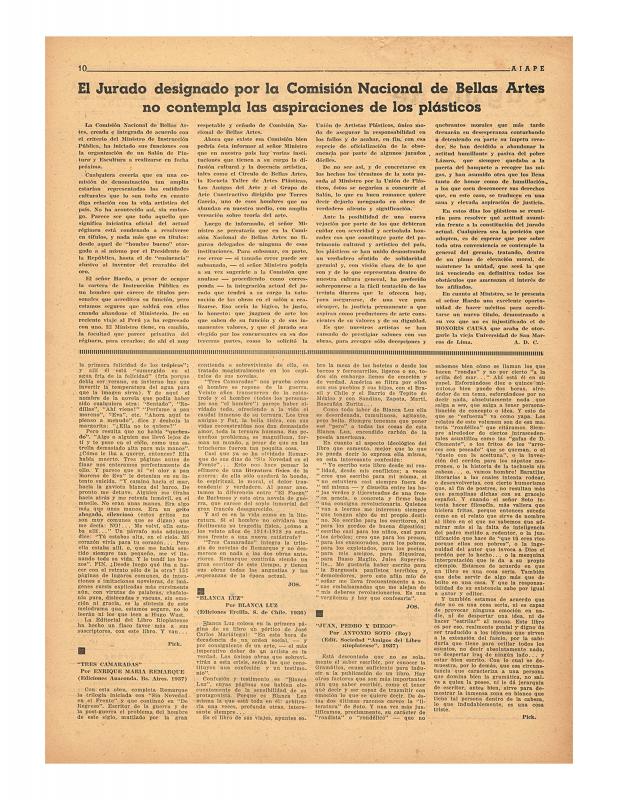Confronted with the advancement of fascism, many of the intellectuals from Rio de la Plata, mainly those allied to the Partido Comunista Uruguayo [PCU, Uruguayan Communist Party], became aligned with the Soviet directives emanating from The Communist International through “popular fronts”. And just as in Buenos Aires a year before the Asociación de Intelectuales, Artistas, Periodistas y Escritores (AIAPE, Association of Intellectuals, Artists, Journalists and Writers)was founded in Montevideo. The collective group operated through its newspaper, also named AIAPE replacing Movimiento the official publication of the Confederación de Trabajadores Intelectuales de Uruguay [CTIU, Confederation of Intellectual Workers of Uruguay]. A network consisting of Latin American intellectuals and artists was consolidated through the AIAPE and the AIAPE foundations established in various South American countries. These were also emerging in Argentina in 1935 at the directive of Aníbal Ponce (1898–1938), whose objective was to combat the situation of cultural decline brought about by conservative and profascist policies. The activities of the AIAPE was disseminated throughout several Latin American countries with similar objectives but with different conditions and with the support of the communist parties throughout the region that were aligned to the Soviet directives emanating from The Communist International. The work of the AIAPE was to amass a vast amount of the intellectual sectors, and place these against the authoritarian pressures brought about by the fascist ideals imposed on the country by the coup-d’etat of 1933 and the dictatorship of Gabriel Terra in Uruguay, reflecting the importance of the AIAPE magazine. The magazine underscored its unconditional support for the Republican Spain thus manifesting the solidarity and union of the Uruguayan Intellectuals against the advance of both class and racist authoritarianism in Europe and America.
[For further reading please refer to the ICAA digital archive for the following texts published by in the AIAPE by Joaquín Torres García: “La exposición. [Amigos de España]” (doc. no. 1191197), “El Arte de Arzádum” (doc. no. 1223148) and “El arte de David Alfaro Siqueiros” (doc. no. 1238628). Also please refer the following texts: “El artista y el Estado” (doc. no. 1216580) by Justino Zavala Muniz, “Arte simple” by Atahualpa del Cioppo (doc. no. 1223119); “Las artes plásticas de 1936 a 1939” (doc. no. 1224706) and “Urruchúa” (doc. no. 1224405) by Carmelo de Arzadum, “Demetrio Urruchúa con Nosotros” (doc. no. 1223661), “Las exposiciones. Las remuneraciones artísticas” (doc. no. 1225449)”, “Los jurados del próximo Salón Nacional de Bellas Artes” (doc. no. 1225548), “Michelena- Escultor” (doc. no. 1223386) and “Plataforma de aspiraciones de los plásticos de la A.I.A.P.E.” (doc. no. 1225398) by Roberto Ibáñez (the responsible editor). “Los estudiantes plásticos y la AIAPE [Agrupación de Intelectuales, Artistas, Periodistas, y Escritores]” (doc. no. 1225286); by Homero Clerici, “El grabador Carlos González” (doc. no. 1223870) by Felipe Novoa, “La nueva Asociación de Artistas Plásticos” (doc. no. 1225166) by Gisleno Aguirre, “Objeto y Significación de Un Salón de Arte” (doc. no. 1210990) by Orestes Baroffio and “Teseo: los problemas del arte” (doc. no. 1223765) by C.L. There is also a significant amount of unsigned texts that were published by the A.I.A.P.E. (Asociación de Intelectuales, Artistas, Periodistas y Escritores [Association of Intellectuals, Artists, Journalists and Writers]): “Temas de discusión sobre la cultura Americana” (doc. no. 1225812),La actividad plástica del año” (doc. no. 1223617), “Alianza de intelectuales, artistas y escritores bolivianos” (doc. no. 1225763), “El arte mejicano” (doc. no. 1225519), “Bases A.I.A.P.E (Agrupación de Intelectuales, Artistas, Periodistas y Escritores)” (doc. no. 1226697)“Cae decorado de Berni bajo la piqueta del G.O.U” (doc. no. 1225213), “Cultura de liberación” (doc. no. 1226424), “Cultura en el orden internacional” (doc. no. 1223996),
“La ética social del artista”, sin forma (doc. no. 1223962), “La exposición del Subte a beneficio de Chile”, sin forma (doc. no. 1225245), “Fuera del Salón Oficial” (doc. no. 1221528), “El jurado designado por la Comisión Nacional de Bellas Artes no contempla las aspiraciones de los plásticos” (doc. no. 1225373), “Los jurados de los salarios artísticos de 1935 atentó contra la cultura” (doc. no. 1225596), “La libertad en Portinari” (doc. no. 1225346),“El mensaje de Antonio Berni” (doc. no. 1223596), “Noticia de David Alfaro Siqueiros” (doc. no. 1223640), “Una opinión sobre el 6° Salón Nacional” (doc. no. 1225722), “Optimismo sobre España” (doc. no. 1225185), “Página de crítica y polémica. Las exposiciones” (doc. no. 1221503), “La pintura en el V Salón de Otoño” (doc. no. 1225672), “Reconocimiento a Élie Faure” (doc. no. 1223458), “VIII Salón Nacional de Bellas Artes” (doc. no. 1211227) and “Sobre la querella del realismo” (doc. no. 1225636)].




